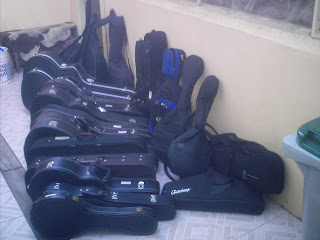
Mandolas and bouzoukis are the ground-up cousins of the mandolin family. Originally they were made using staved ribs for the bowlback with a canted flat top according to the napolitan and greek tradition. The greeks around 1930 transformed it with a napolitan fashion and a western fretscale the longest scale of the three courses turkish buzuk saz creating in this process the
bouzouki. At the end of the XIX century, makers in Portugal, France and later in United States started to make larger flat back models and even carved archtop instruments such as those by Gibson for mandolas, and mandocellos tuned CGDA/Cgda, mimicking in that way the same tuning of the equivalent classical string instruments.
Nevertheless, since tle late 60's, some players such as
Andy Irvine were using portuguese guitars and other folk citterns to play irish folk music and from this succesful experience many more large flat top mandolin family instruments with a simpler flatback and lower octave tuning like GDAE/GDAD started to be made to play traditional western european music such as the irish, scottish, and later on since the late 80's also in breton, galician, asturian and many other european folk traditions. Most of these musical traditions have been labeled under the name celtic, so to these instruments too.
Examples from
my collection for these instruments with their scale lengths are shown in the photo above. Clockwise, from top to bottom: a Fender bouzouki (66 cm SL), Flatiron bouzouki/OM (60 cm SL), Musikalia octave mandola (53 cm SL), Salterio/Gremlin mandola (42.5 cm), and on the bottom some citterns that were instruments after which some of these larger instruments were modeled such as a Kirsinger bandola/ waldzither (43 cm SL) , and a portuguese Coimbra guitar (47 cm. SL).
In South America, these instruments are barely known. Nevertheless, like in Europe, at the beginning of the XX century there were local historical makers of the classical mandolas such as
Kirsinger in Chile and
Breyer in Argentina. Therefore, as they are little known we show them at workshops, showcases and performances at schools and at the festival FIMIV we organise every year in Valparaiso.
Currently, in the larger cities and especially in Chile and Argentina, there are more than a few players and celtic bands using these instruments (e.g.
banda celtamericana), playing mostly on korean made generic brands or italian makes such as those by Musikalia, plus the ocassional luthier handmade instruments by a very few. There is even an argentinean luthier specialized on these instruments:
Aicardi & Moore.
 A new renovated summer programme staging free plays, music and other artistic shows is being organised by the Heritage and Cultural office of the local city council. Most of them scheduled to start during weekdays just before sunset at squares like plazuela Anibal Pinto, Plaza Victoria and Cívica. More info at:
A new renovated summer programme staging free plays, music and other artistic shows is being organised by the Heritage and Cultural office of the local city council. Most of them scheduled to start during weekdays just before sunset at squares like plazuela Anibal Pinto, Plaza Victoria and Cívica. More info at:
 Valparaiso
Valparaiso
















